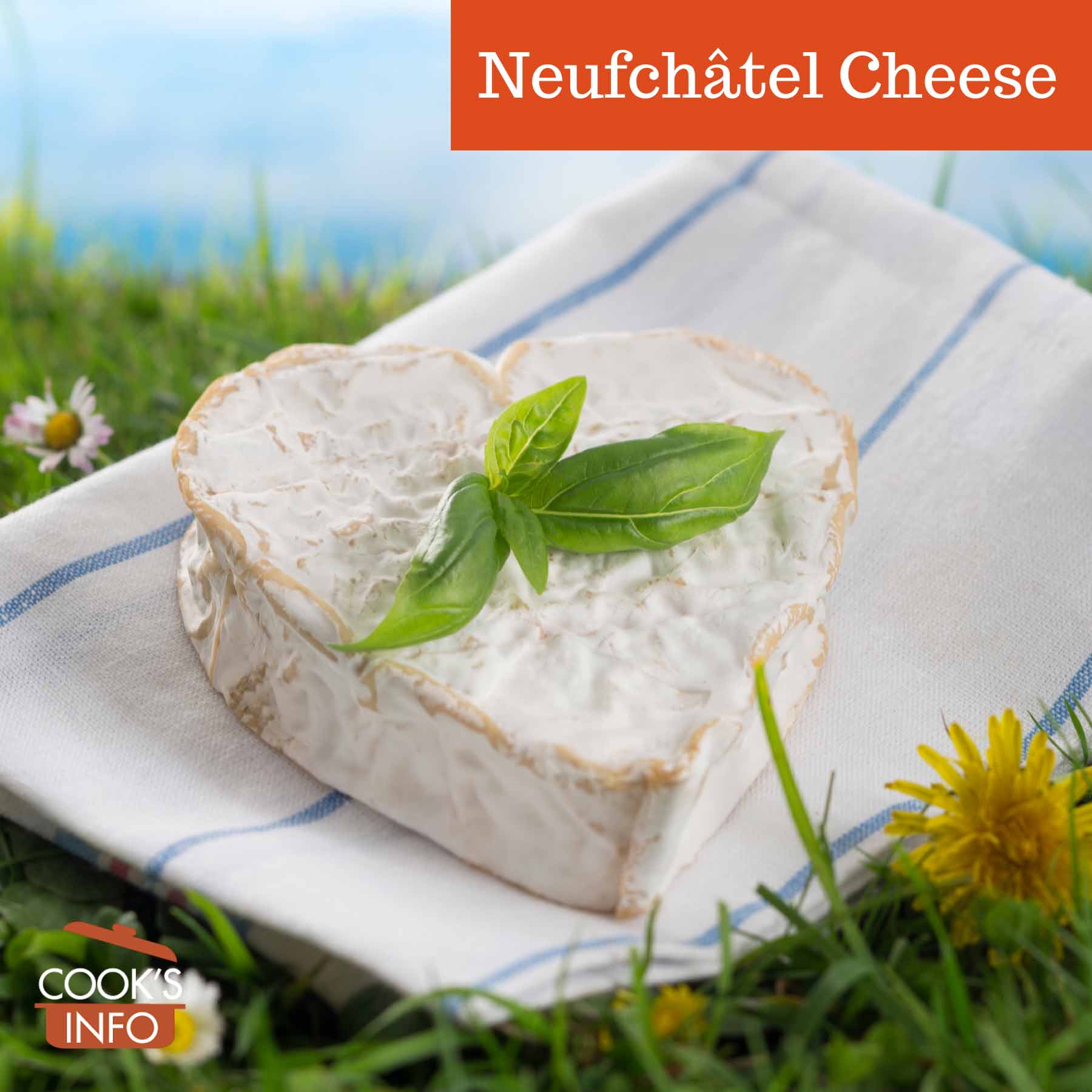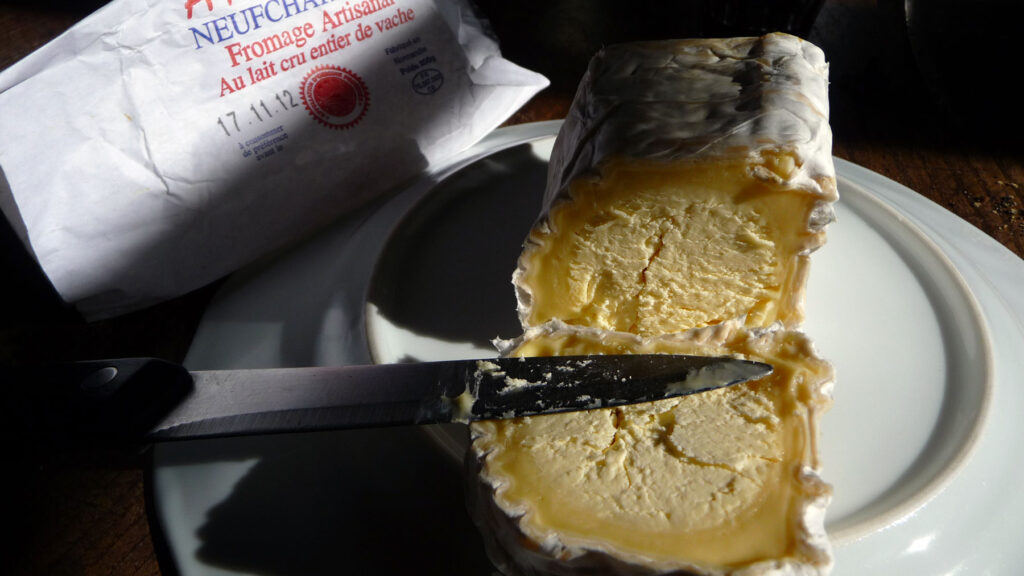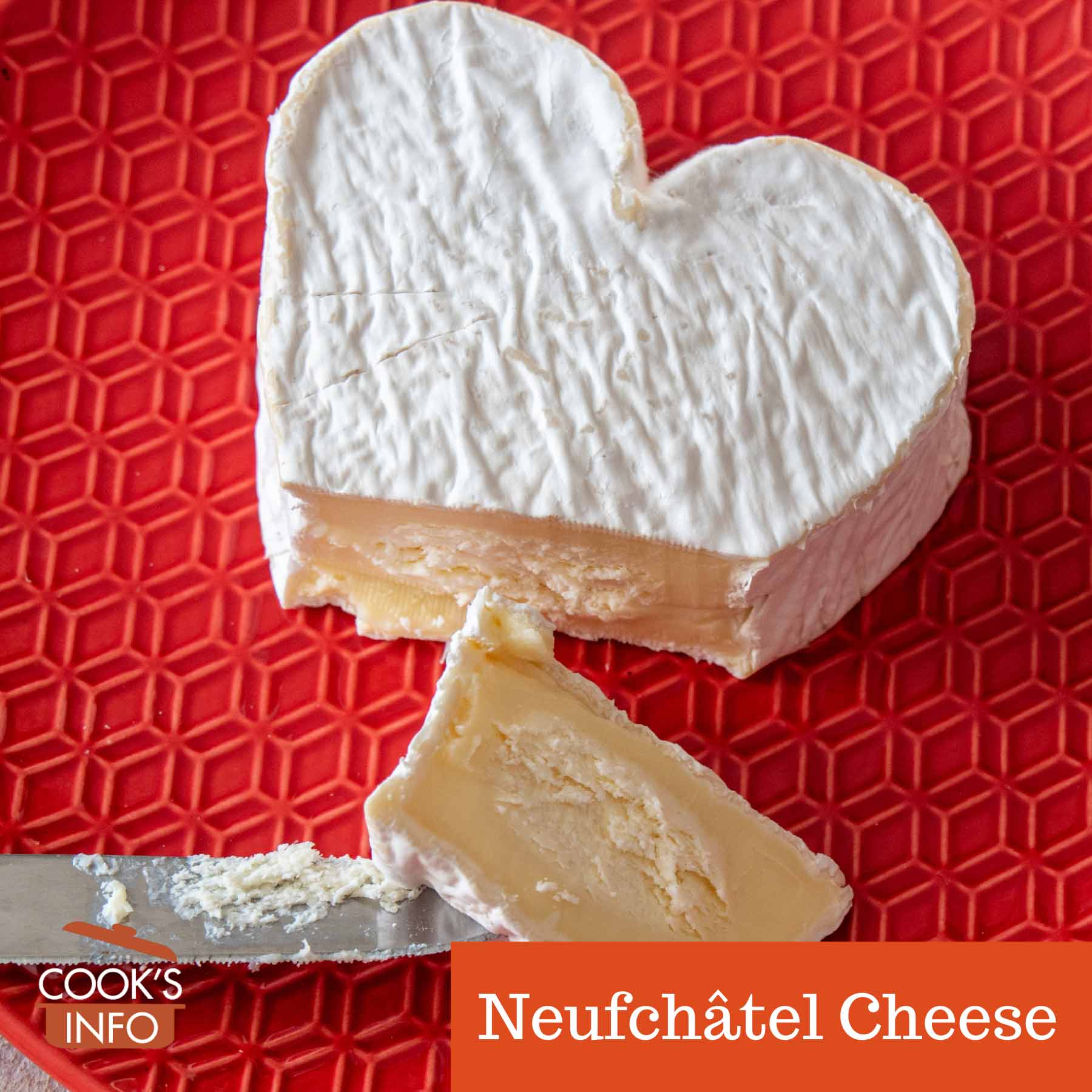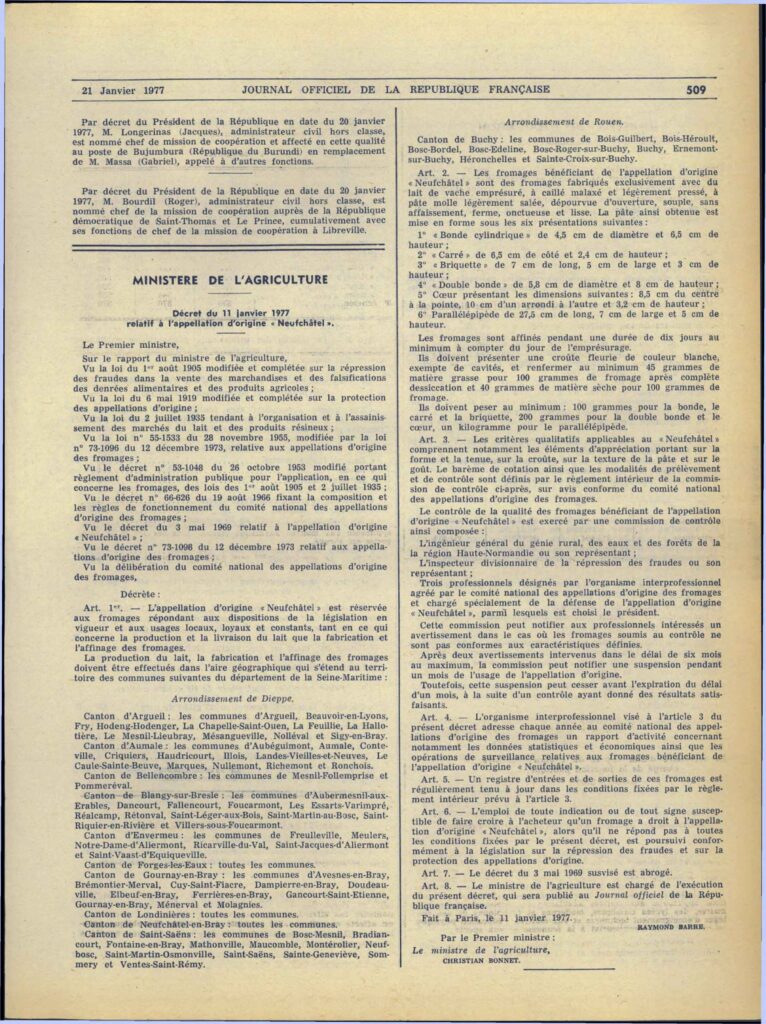
Neufchâtel Cheese. JPC-PROD / Getty Images via Canva Pro
Neufchâtel cheese is a soft, spreadable French cheese, that’s similar to cream cheese, but as it is made with whole milk with no cream added, it is firmer, less smooth, and grainier. It has a slight tang to its taste.
The cheese will be aged for a minimum of ten days, but can be aged up to three months. The crust on the outside, particularly for aged ones, looks like that of Brie or Camembert.
It is made in the Neufchâtel-en-Bray area of Normandy, France.
To protect against lower-quality industrial imitators, the use of the name Neufchâtel cheese is governed by a French “Appellation of Controlled Origin” (AOC).
Making Neufchâtel cheese
In 2017, a requirement was put into place that 60% of the milk be from the Normande breed of dairy cattle from the Normandy region of north-west France. [1]A partir du 1er juin 2017, le troupeau de chaque des producteur de lait destiné à la fabrication de « Neufchâtel » comprend au moins 60 % d’animaux de race normande. — Cahier des charges de l’appellation d’origine “Neufchâtel”. Montreuil Sous Bois: Institut National de l’Origine et de la Qualité (INAO). 2017. Page 6. This percentage has varied over the years.
The milk used will be either raw milk, thermalized, or pasteurized. [2]AOP Laitières. Neufchâtel. Accessed April 2022 at https://www.produits-laitiers-aop.fr/produits/neufchatel/ For cheeses destined for export to the North American market, the milk will be pasteurized.
To make the cheese, the milk is heated to around 20 C (68 F), at which point rennet is added and the milk allowed to coagulate for 1 to 1 ½ days. Unlike most other cheeses, the curd is not cut. It’s then hung in cloth bags to drain for half a day, after which pieces of mature Neufchâtel are added and the curd put into moulds and covered and salted. They are allowed to age for about 10 days, though they can be aged longer. The rinds develop a white powder on them, which is penicillium candidum. Cheeses are that aged longer will be slightly yellow with red spots on them.
It is made in six shapes that are defined by regulations governing the cheese: [3]”A l’issue du délai minimum d’affinage prévu au chapitre 5 relatif à la méthode d’obtention, le “Neufchâtel” pèse au minimum 100 g pour la bonde, le carré et la briquette ; 200 g pour le coeur et la double bonde et 600 g pour le grand coeur.” — Cahier des charges de l’appellation d’origine “Neufchâtel”. Montreuil Sous Bois: Institut National de l’Origine et de la Qualité (INAO). 2017. [4]Fiche produit: Neufchâtel. Institut National de l’Origine et de la Qualité (INAO). 23 March 2022. Accessed April 2022 at https://www.inao.gouv.fr/produit/13169
- Bondon or bonde (cylinder shaped, 4.5 cm in diameter by 6.5 cm long. 100 g);
- Briquette (brick, 7 cm long, 5 cm wide, 3 cm high. 100 g);
- Carré (square, 6.5 cm x 6.5 cm by 2.4 cm high. 100 g);
- Cœur (heart, 8.5 cm from the centre to tip, 10 cm from one round edge to the other, 3.2 cm high. 200 g);
- Double bonde (double cylinder, 5.8 diameter, 8 cm long. Twice the weight of a bondon, 200 g);
- Grand cœur or gros cœur (large heart, 10.5 cm from the centre to tip, 11 cm from one round edge to the other, 5 cm high. 3 x the weight of a cœur, 600 g). [5]The 6th shape was defined in the original 1977 AOC as a parallelepiped, but seems to have been discontinued along the way in favour of the double-heart: “Parallélépipède de 27,5 cm de long, 7 cm de large et 5 cm de hauteur.” — Journal officiel de la République française. Lois et décrets. n° 0017 du 21/01/1977. P. 509.

Neufchâtel Cheese in a cylinder shape (aka bondon or bond). Lagric / wikimedia / 2012 / CC BY-SA 3.0

Neufchâtel Cheese Heart. PhilipImage / Getty Images via Canva Pro.
By the start of the 2000s, the heart had become the most popular shape both for consumers and social media photographers. [6]”Le “cœur”, rare au début du XXième siècle, qui est devenu au début du troisième millénaire, la forme la plus répandue de ce fromage emblématique du pays de Bray.” — Fiche produit: Neufchâtel. Institut National de l’Origine et de la Qualité (INAO). 23 March 2022. Accessed April 2022 at https://www.inao.gouv.fr/produit/13169
Nutrition
Neufchâtel cheese is slightly lower in fat than cream cheese as it is made from just milk instead of milk enriched with cream. Minimum 45% fat content, sometimes up to 50%. [7]”Ce fromage présente au moins 45 % mais le plus souvent 50% de matière grasse sur sec.” — Fiche produit: Neufchâtel. Institut National de l’Origine et de la Qualité (INAO). 23 March 2022. Accessed April 2022 at https://www.inao.gouv.fr/produit/13169
Per 100 g (3.5 oz): Calories 260, Fat 23.43 g, Saturated 14.797 g, Cholesterol 76 mg, Carbohydrate 3 g, Fibre 0 g, Sugars 0 g, Protein 10 g, Calcium 75 mg
History Notes
Neufchâtel Cheese was first documented in 1543, though boosters of the cheese date it back to the 11th century on somewhat tenuous evidence. [8]”Les origines du fromage de “Neufchâtel” remontent au 10ème siècle. Pour Ghislain Gaudefroy, le Neufchâtel est parmi les plus anciens fromages normands et s’apparente aux fromages fabriqués dans le pays de Bray qui sont mentionnés, pour la première fois, dans une charte datant de 1037. En 1050, le seigneur Hugues De Gournay confère à l’abbaye de Sigy-la-Dîme des frometons perçus sur paysans de la Vallée de Bray se livrant au commerce de leurs fromages. Le Pays de Bray est en effet avec le Pays d’Auge, l’une des deux plus anciennes régions de tradition fromagère de Normandie.” — Cahier des charges de l’appellation d’origine “Neufchâtel”. Montreuil Sous Bois: Institut National de l’Origine et de la Qualité (INAO). 2017. Page 10.
Though this was a fresh cheese, not capable of travelling long distances, getting the cheese to their customers wasn’t a problem for the producers: the markets of Paris were only 130 km (80 miles) away.
Neufchâtel cheese received its French AOC in 1977. [9]”Après de longues démarches, les éleveurs du Pays de Bray aboutissent en 1977 à la reconnaissance en A.O.C. du fromage Neufchâtel.” — Fiche produit: Neufchâtel. Institut National de l’Origine et de la Qualité (INAO). 23 March 2022. Accessed April 2022 at https://www.inao.gouv.fr/produit/13169
Language notes
Confusion of Neufchâtel with Neuchâtel, as in the city and canton in Switzerland, leads some to think this is a Swiss cheese.

Neufchâtel cheese cross-section. Coyau / Wikimedia Commons / 2015 / CC BY-SA 3.0
Further reading
Journal officiel de la République française. Lois et décrets. n° 0017 du 21/01/1977

(Click to enlarge.) Granting of an AOC for Neufchâtel Cheese in 1977. Journal officiel de la République française. Lois et décrets. n° 0017 du 21/01/1977
References
| ↑1 | A partir du 1er juin 2017, le troupeau de chaque des producteur de lait destiné à la fabrication de « Neufchâtel » comprend au moins 60 % d’animaux de race normande. — Cahier des charges de l’appellation d’origine “Neufchâtel”. Montreuil Sous Bois: Institut National de l’Origine et de la Qualité (INAO). 2017. Page 6. |
|---|---|
| ↑2 | AOP Laitières. Neufchâtel. Accessed April 2022 at https://www.produits-laitiers-aop.fr/produits/neufchatel/ |
| ↑3 | ”A l’issue du délai minimum d’affinage prévu au chapitre 5 relatif à la méthode d’obtention, le “Neufchâtel” pèse au minimum 100 g pour la bonde, le carré et la briquette ; 200 g pour le coeur et la double bonde et 600 g pour le grand coeur.” — Cahier des charges de l’appellation d’origine “Neufchâtel”. Montreuil Sous Bois: Institut National de l’Origine et de la Qualité (INAO). 2017. |
| ↑4 | Fiche produit: Neufchâtel. Institut National de l’Origine et de la Qualité (INAO). 23 March 2022. Accessed April 2022 at https://www.inao.gouv.fr/produit/13169 |
| ↑5 | The 6th shape was defined in the original 1977 AOC as a parallelepiped, but seems to have been discontinued along the way in favour of the double-heart: “Parallélépipède de 27,5 cm de long, 7 cm de large et 5 cm de hauteur.” — Journal officiel de la République française. Lois et décrets. n° 0017 du 21/01/1977. P. 509. |
| ↑6 | ”Le “cœur”, rare au début du XXième siècle, qui est devenu au début du troisième millénaire, la forme la plus répandue de ce fromage emblématique du pays de Bray.” — Fiche produit: Neufchâtel. Institut National de l’Origine et de la Qualité (INAO). 23 March 2022. Accessed April 2022 at https://www.inao.gouv.fr/produit/13169 |
| ↑7 | ”Ce fromage présente au moins 45 % mais le plus souvent 50% de matière grasse sur sec.” — Fiche produit: Neufchâtel. Institut National de l’Origine et de la Qualité (INAO). 23 March 2022. Accessed April 2022 at https://www.inao.gouv.fr/produit/13169 |
| ↑8 | ”Les origines du fromage de “Neufchâtel” remontent au 10ème siècle. Pour Ghislain Gaudefroy, le Neufchâtel est parmi les plus anciens fromages normands et s’apparente aux fromages fabriqués dans le pays de Bray qui sont mentionnés, pour la première fois, dans une charte datant de 1037. En 1050, le seigneur Hugues De Gournay confère à l’abbaye de Sigy-la-Dîme des frometons perçus sur paysans de la Vallée de Bray se livrant au commerce de leurs fromages. Le Pays de Bray est en effet avec le Pays d’Auge, l’une des deux plus anciennes régions de tradition fromagère de Normandie.” — Cahier des charges de l’appellation d’origine “Neufchâtel”. Montreuil Sous Bois: Institut National de l’Origine et de la Qualité (INAO). 2017. Page 10. |
| ↑9 | ”Après de longues démarches, les éleveurs du Pays de Bray aboutissent en 1977 à la reconnaissance en A.O.C. du fromage Neufchâtel.” — Fiche produit: Neufchâtel. Institut National de l’Origine et de la Qualité (INAO). 23 March 2022. Accessed April 2022 at https://www.inao.gouv.fr/produit/13169 |

